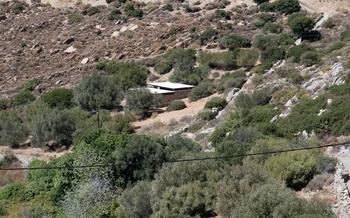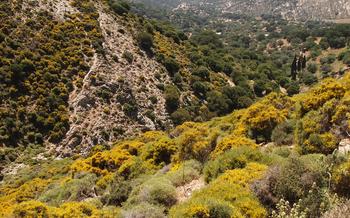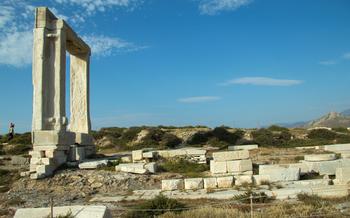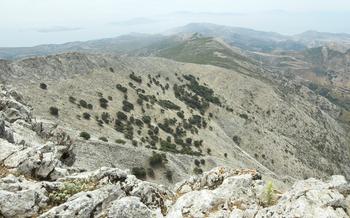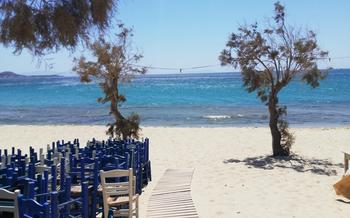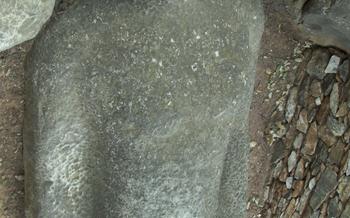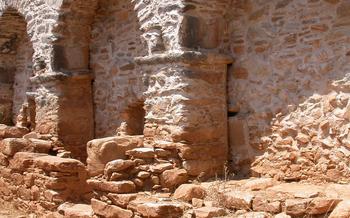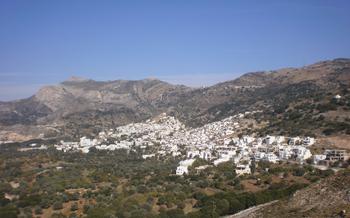
Temple of Demeter
- Historical Significance
- Location and Getting There
- Opening Hours and Admission Fees:
- Guided Tours and Audio Guides
- Things to See and Explore
- Historical Context
- Nearby Attractions
- Accessibility and Facilities:
- Events and Festivals
- Photography and Videography
- Weather and Clothing
- Accommodation and Hotels
- Insider Tip:
Historical Significance
Journey back in time to explore the ancient history and profound significance of the Temple of Demeter, a sanctuary dedicated to the revered Greek goddess of agriculture and harvest. Delve into the captivating mythology surrounding Demeter, whose pivotal role in the cycle of seasons and fertility earned her a prominent place in the Greek pantheon. Discover the temple's compelling connection to Naxos, an island steeped in rich history and natural beauty.
Unravel the intriguing story behind the temple's construction, learning about its unique architectural features and the skilled craftsmanship that brought it to life. Admire the well-preserved columns, intricate pediments, and exquisite sculptures that adorn the temple's facade, each element a testament to the artistry and devotion of ancient Greek builders. Understand the temple's central role in religious ceremonies and festivals, as the community gathered to honor Demeter and seek her blessings for bountiful harvests and prosperity.
Location and Getting There
The Temple of Demeter is situated in the southeastern part of Naxos, approximately 15 kilometers from Naxos Town, the island's main port and capital. To reach the temple, you can either rent a car and enjoy the scenic drive through the countryside or take a bus from Naxos Town, which offers regular service to the temple's vicinity. Taxis are also available for hire if you prefer a more convenient option.
For those who prefer self-navigation, follow the signs towards the village of Sangri from Naxos Town. Once you reach Sangri, continue for another 3 kilometers until you see the temple on your right-hand side. Ample parking space is available near the temple, allowing you to park your vehicle and embark on your exploration of this ancient site.
Opening Hours and Admission Fees:
The Temple of Demeter is open to the public daily, except for major holidays. During the summer season (April to October), the temple is generally open from 8:00 AM to 8:00 PM. In the winter season (November to March), the hours may be shorter, typically from 9:00 AM to 5:00 PM.
Admission to the temple is free of charge, making it accessible to visitors of all budgets. There are no special requirements or restrictions for entry, and visitors are welcome to explore the temple at their leisure.
For further inquiries about visiting hours or any special events, visitors can contact the Naxos Archaeological Museum at (+30) 22850 22720 or visit their website for the most up-to-date information.
Guided Tours and Audio Guides
The Temple of Demeter offers guided tours led by experienced historians or archaeologists who provide in-depth knowledge and insights into the temple's history, architecture, and significance. These tours are highly recommended for those who want to learn more about the ancient world and the goddess Demeter. Visitors can book guided tours in advance through the temple's website or through local tour operators.
For those who prefer a more independent experience, audio guides are also available for rent at the temple. These audio guides provide detailed information about the temple's various features and allow visitors to explore at their own pace. The audio guides are available in multiple languages, making them accessible to visitors from all over the world.
Things to See and Explore
The Temple of Demeter is an architectural masterpiece that showcases the grandeur and artistry of ancient Greece. As you approach the temple, you will be awestruck by its well-preserved columns, which stand tall and proud, defying the ravages of time. The temple's pediments, adorned with intricate carvings and sculptures, depict scenes from Greek mythology, offering a glimpse into the beliefs and values of the ancient Greeks.
Inside the temple, you can admire the impressive sculptures and artifacts that have been carefully preserved. These relics provide valuable insights into the religious practices and rituals that took place within the temple walls. Take your time to explore the temple's various chambers and corridors, each with its unique features and stories to tell.
Don't forget to venture outside the temple and admire the surrounding landscape. The temple is situated on a hilltop, offering panoramic views of the fertile valleys and the sparkling Aegean Sea. Capture the beauty of this ancient site with your camera, ensuring you have lasting memories of your visit to the Temple of Demeter.
Historical Context
The Temple of Demeter stands as a testament to the rich history and cultural significance of Naxos. During ancient times, Naxos was a prominent island in the Aegean Sea, known for its wealth, power, and influence. It was a center of trade, religion, and politics, attracting visitors and settlers from across the Mediterranean.
The temple's construction coincided with Naxos's rise to prominence. The Naxians, known for their skill in architecture and craftsmanship, built the temple as a symbol of their devotion to the goddess Demeter and as a reflection of their island's prosperity.
Throughout the centuries, the temple has withstood the test of time. It survived foreign invasions, natural disasters, and changes in religious practices. Its enduring presence speaks to the enduring legacy of the ancient Greeks and their deep reverence for their deities.
Today, the Temple of Demeter stands as a reminder of Naxos's glorious past. It is a symbol of the island's cultural heritage and a source of pride for the Naxian people. Visitors to the temple can immerse themselves in the history of ancient Greece and experience the enduring power of its mythology and religious traditions.
Nearby Attractions
After exploring the ancient history and spiritual significance of the Temple of Demeter, visitors can venture into the surrounding area to discover a wealth of other attractions. A short walk from the temple leads to the picturesque village of Sangri, known for its charming whitewashed houses, narrow cobblestone streets, and traditional tavernas serving delicious Greek cuisine.
For those seeking a refreshing dip in the crystal-clear waters of the Aegean Sea, Agios Prokopios Beach is just a 10-minute drive from the temple. This beautiful beach boasts soft golden sand, shallow waters ideal for swimming, and stunning views of the nearby islands. Visitors can rent sunbeds and umbrellas, indulge in water sports, or simply relax and soak up the sun.
History buffs can explore the nearby Venetian Castle of Naxos, located in the heart of Naxos Town. This imposing fortress, built in the 13th century, offers a glimpse into the island's rich past. Visitors can wander through its well-preserved ruins, climb to the top of the ramparts for panoramic views, and learn about the castle's role in defending Naxos from invaders.
To experience the natural beauty of Naxos, visitors can venture into the mountainous interior, where they will find lush forests, cascading waterfalls, and traditional villages nestled amidst olive groves. The village of Filoti, known for its picturesque scenery and traditional architecture, is a popular starting point for hiking and mountain biking trails.
Whether you seek relaxation on the beach, exploration of historical sites, or immersion in the natural beauty of the island, the area surrounding the Temple of Demeter offers an array of attractions for every traveler.
Accessibility and Facilities:
The Temple of Demeter is committed to providing an accessible and welcoming environment for all visitors. The temple grounds are well-maintained and feature ramps and accessible pathways, making it easy for visitors with wheelchairs or other mobility aids to navigate the site. Additionally, there are several accessible restrooms available for visitors' convenience. For those with hearing impairments, audio guides with closed captioning are available upon request. The temple staff is friendly and accommodating, always willing to assist visitors with any accessibility needs they may have. To further enhance the visitor experience, there is a visitor center located near the temple entrance, providing information, maps, and brochures in multiple languages. Restrooms, drinking fountains, and a small cafe serving refreshments and snacks are also available at the visitor center, making it a convenient stop during your visit.
Events and Festivals
The Temple of Demeter and its surroundings play host to several captivating festivals and events throughout the year, each steeped in tradition and local customs. One of the most significant events is the annual Panagia Drosiani Festival, held on August 15th. This religious celebration honors the Virgin Mary and features a procession carrying her sacred icon through the village of Sangri, accompanied by traditional music and dancing.
Another notable event is the Naxos Music Festival, held in July, which brings together talented musicians and artists from around the world for a series of concerts and performances. Set against the backdrop of the ancient temple, these performances create a magical atmosphere that transports visitors back in time.
For those interested in experiencing local culinary delights, the Naxos Food Festival, held in September, showcases the island's rich gastronomic heritage. Visitors can savor traditional dishes, sample local wines, and witness cooking demonstrations by renowned chefs, all while enjoying the vibrant atmosphere of the festival.
These are just a few of the many events and festivals that Naxos offers. By aligning your visit with one of these special occasions, you'll have the opportunity to immerse yourself in the island's vibrant culture and create memories that will last a lifetime.
Photography and Videography
The Temple of Demeter is a treasure trove for photography enthusiasts, with its picturesque ruins and stunning surroundings. The temple's weathered columns, intricate carvings, and panoramic views make for captivating shots that will transport you back in time.
For the best photographic experience, visit the temple during the golden hour, when the soft light casts a warm glow on the ancient stones. Tripod use is recommended for capturing sharp images, especially during low-light conditions.
While photography is generally permitted, it's essential to be respectful of the temple's sacred nature and avoid using flash or disturbing other visitors. Videography is also allowed, but commercial filming may require special permission.
Capture the temple's grandeur from various angles, experimenting with different perspectives to create unique compositions. Don't forget to include the surrounding landscape, which offers breathtaking views of the Aegean Sea and the lush Naxian countryside.
Weather and Clothing
Naxos enjoys a pleasant Mediterranean climate with hot, dry summers and mild winters. The best time to visit the Temple of Demeter and explore Naxos is during the shoulder seasons, from April to May and from September to October, when the weather is warm and sunny without being overwhelmingly hot.
When packing for your trip, consider lightweight, breathable clothing suitable for warm weather. Comfortable walking shoes or sandals are a must for navigating the uneven terrain around the temple. A hat, sunglasses, and sunscreen are essential for protection from the strong Greek sun. During the summer months, temperatures can reach the high 30s Celsius, so staying hydrated is crucial. Bring a refillable water bottle and consider packing a small cooler with snacks and drinks if you plan on spending an extended period at the temple.
In case of unpredictable weather conditions, a light jacket or sweater is recommended, especially during the evenings or early mornings. Naxos is known for its strong winds, particularly during the summer months, so be prepared for occasional gusts. Layered clothing allows for easy adjustment to the changing weather conditions.
Accommodation and Hotels
Naxos offers a diverse range of accommodation options to suit various budgets and preferences. For a convenient and immersive experience, consider staying at a hotel or guesthouse near the Temple of Demeter. Numerous charming hotels and traditional Greek guesthouses are located within walking distance of the temple, providing easy access to its ancient wonders.
When selecting your accommodation, consider factors such as proximity to the temple, amenities, and budget. Many hotels offer stunning views of the temple and the surrounding landscape, making for a memorable stay.
For a luxurious experience, opt for one of the upscale hotels that offer modern amenities, private balconies, and exceptional service. If you prefer a more budget-friendly option, there are several guesthouses and apartments available that provide comfortable accommodations at affordable rates.
To ensure a hassle-free stay, it is advisable to book your accommodation in advance, especially during the peak tourist season. This will guarantee availability and allow you to choose from a wider range of options.
Whether you seek a luxurious retreat or a cozy and affordable stay, Naxos has something to offer every traveler. Embrace the island's hospitality and make your visit to the Temple of Demeter an unforgettable experience.
Insider Tip:
For a truly unique experience, visit the Temple of Demeter during the annual Demeter Festival, held in August. This vibrant celebration honors the goddess with traditional music, dancing, and reenactments of ancient rituals. Immerse yourself in the rich cultural heritage of Naxos as you witness locals dressed in traditional costumes and participate in lively festivities. It's an unforgettable opportunity to connect with the history and spirit of the island.

